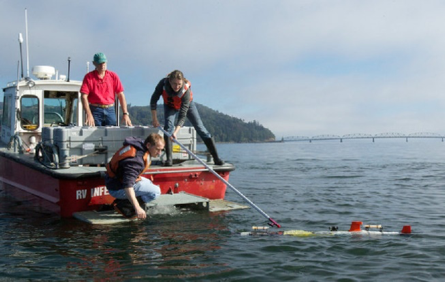You are here
Remotely Controlled Samplers Roam the Bottom of the Columbia River
 The Columbia River presents experimental oceanographers with severe sampling challenges. Ebb currents, which are regularly in excess of 3 m/s, cause standard shipboard rosette CTD samplers to be swept downstream of an anchored ship. Surface moorings are moved considerably by the currents or even carried to sea when entangled in debris (entire trees with roots go down river during freshet). Only by using smaller, pared-down, profiling packages with considerable weight can measurements be taken near the river bed. Notwithstanding these challenges, the Center for Coastal Margin Observation & Prediction (CMOP) has learned over the last 7 years how to supplement shipboard sampling with measurements made using underwater robots.
The Columbia River presents experimental oceanographers with severe sampling challenges. Ebb currents, which are regularly in excess of 3 m/s, cause standard shipboard rosette CTD samplers to be swept downstream of an anchored ship. Surface moorings are moved considerably by the currents or even carried to sea when entangled in debris (entire trees with roots go down river during freshet). Only by using smaller, pared-down, profiling packages with considerable weight can measurements be taken near the river bed. Notwithstanding these challenges, the Center for Coastal Margin Observation & Prediction (CMOP) has learned over the last 7 years how to supplement shipboard sampling with measurements made using underwater robots.
Dr. Craig McNeil and his team at the Applied Physics Laboratory at the University of Washington use two Autonomous Underwater Vehicles (AUVs; Kongsberg Maritime REMUS 100) to gain the maneuverability and access other sampling approaches lack. The vehicles navigate underwater acoustically, distance-ranging on transponders submerged in weaker current areas near the edges of the channel at precise known locations. They have spent considerable time learning (with rigging tips from the local crab pot fishermen!) how to keep these acoustic transponders from moving yet still be recoverable by small boat at the end of the experiment.
To help plan AUV missions and minimize the chances of mission aborts and vehicle loss while maximizing the collection of valuable data, before each mission we simulate the AUV’s expected track line in CMOP’s SELFE numerical forecast model flow fields. Simulating the mission allows us to identify optimal routes and avoid the strongest currents, or work with them (going with the flow). The model also helps target our observations on the particular transient features (salt wedge, ETM, etc.) being studied by identifying when and where the features are likely to be.
 Each AUV carries the following sensors: upward and downward looking 1.2 MHz ADCPs (Teledyne RD Instruments), mounted forward on the vehicle; a SBE-49 CTD (Sea-Bird Electronics, Inc.) sampling 16 times per second; a fast-response model 4330 oxygen sensing optode (Aanderaa Inc.), mounted on the forward starboard side. An additional customized sensor package, available for use on either vehicle, contain two WET Labs ECO puck triplets for optical backscatter at 700 nm or 880 nm, and measurement of chlorophyll, phycoerythrin, phycocyanin, and CDOM fluorescence.
Each AUV carries the following sensors: upward and downward looking 1.2 MHz ADCPs (Teledyne RD Instruments), mounted forward on the vehicle; a SBE-49 CTD (Sea-Bird Electronics, Inc.) sampling 16 times per second; a fast-response model 4330 oxygen sensing optode (Aanderaa Inc.), mounted on the forward starboard side. An additional customized sensor package, available for use on either vehicle, contain two WET Labs ECO puck triplets for optical backscatter at 700 nm or 880 nm, and measurement of chlorophyll, phycoerythrin, phycocyanin, and CDOM fluorescence.
To date we have successfully conducted over 50 missions in the Columbia River to study red phytoplankton blooms, suspended sediments, and mixing of fresh and saltwater at the river’s mouth. We have plans to continue using AUVs in the Columbia River estuary to study turbulence and mixing, phytoplankton blooms, and underwater ambient sound generation mechanisms. A legacy of CMOP will be a trained and competent AUV team who are able to apply the experience and knowledge gained while operating the vehicles in the Columbia River to other post-2016 scientific endeavors in the Pacific Northwest and elsewhere.
Written by Craig McNeil






